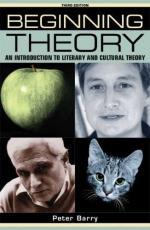
|
| Name: _________________________ | Period: ___________________ |
This quiz consists of 5 multiple choice and 5 short answer questions through Stylistics.
Multiple Choice Questions
1. What was the term used in the Introduction that is defined as the science of signs?
(a) Mimesis.
(b) Semiotics.
(c) Logocentrism.
(d) Phenomenology.
2. Which of the following authors wrote the essay "What Has Never Been: An Overview of Lesbian Feminist Criticism" and attacked "essentialism," pointing out the way "the perceptual screen of hetero-sexism" prevented any consideration of lesbian issues in pioneering feminist writing?
(a) Bonnie Zimmerman.
(b) Muriel Spark.
(c) Anne Koedt.
(d) Adrienne Rich.
3. W.B. Yeats was a member of the ________ ruling class in ________, according to the narrator in the chapter titled "Postcolonial Criticism."
(a) Aethist / America.
(b) Protestant / Ireland.
(c) Amish / Sweden.
(d) Jewish / Poland.
4. What where the only two universities in England in the nineteenth century?
(a) Manchester and Winchester.
(b) Birmingham and Buckingham.
(c) Kingston and Liverpool.
(d) Oxford and Cambridge.
5. The narrator explains in the chapter "Psychoanalytic Criticism" that distrust of Freud has grown in recent years, partly as a result of his mainly negative views on ________.
(a) Children.
(b) Americans.
(c) Men.
(d) Women.
Short Answer Questions
1. Whom does author Peter Barry say was a French psychoanalyst whose work had an extraordinary influence upon many aspects of recent literary theory and who began his career by taking a medical degree and then training in psychiatry in the 1920s?
2. According to the narrator in the Introduction, the ________ probably saw the high-water mark of literary theory.
3. Which of the following realism terms best illustrates the straight realism which was imposed in the 1930s?
4. The thesis that the language is "masculine" was developed by ________ in the early 1980s in her book "Man Made Language," which also argues that language is not a neutral medium.
5. What language does the narrator describe as being a Romance language that takes most of its words directly from Latin, and lacks the reassuring Anglo-Saxon layer of vocabulary?
|
This section contains 318 words (approx. 2 pages at 300 words per page) |

|




